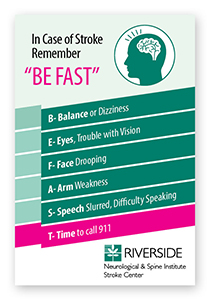Despite its role as a major cause of death and the leading cause of disability, many Americans still do not think of stroke as a major health concern. A survey conducted a few years ago by the Centers for Disease Control and Prevention revealed that only 38 percent of the individuals surveyed correctly identified the symptoms of stroke and knew to call 911 if they suspected a stroke in progress.
Did you know?
- Stroke is the nation's fifth leading cause of death, and the fourth leading cause of death in Virginia.
- On average, someone suffers a stroke every 40 seconds.
- About 55,000 more women than men have a stroke each year
- Stroke is also a leading cause of serious, long-term disability
- 80 percent of all strokes can be prevented
Source: American Heart Association and the American Stroke Association
A stroke occurs when there is bleeding in the brain or normal blood flow to the brain is blocked. Within minutes, brain cells start dying. Fast diagnosis and treatment of a stroke is critical in saving as much brain function as possible.
Patients who arrive at the Emergency Department within 24 hours of their initial symptoms tend to be significantly healthier and less disabled after a stroke than those whose care was delayed.
- If an ischemic stroke takes place (caused when a clot blocks blood flow to the brain), getting to a hospital as soon as possible enables medical teams to dissolve or remove the clot through a number of procedures.
- With hemorrhagic stroke (caused when a blood vessel or an aneurysm in the brain leaks or ruptures), the faster the individual can receive treatment to prevent re-bleeding, the less likely the chance of serious disability or death.
This points to a need for public awareness about BE FAST, an acronym for things to look for in a suspected stroke victim:

B – Balance: Sudden dizziness or loss of balance or coordination
E – Eyes: Sudden trouble seeing in one or both eyes
F – Face: Does the face droop on one side when the person smiles?
A – Arm: After raising both arms, does one of the arms drift downwards?
S – Speech: Does the person have trouble speaking or seem confused?
T – Time: If any or all of the above are observed call 911.
The National Stroke Association, the American Stroke Association and the CDC are all in agreement that many lives could be saved, and many disabilities lessened if this simple but critical reminder is followed.
Growing statistical evidence shows that older adults aren't the only people who should be concerned about stroke. Stroke occurrence has risen significantly in younger adults in the 20 to 55 age group, making many more people vulnerable. In fact, a little more than one-third of the people hospitalized for stroke last year were younger than age 65.
This increase is generally attributed to a concurrent rise in risk factors like diabetes, obesity, high cholesterol, and lifestyle factors. The CDC considers the trend of particular concern in the area of public health because strokes in younger people translate to longer-term lifetime disability.
There are a number of factors linked to an increased risk of stroke or recurrent stroke, including having heart disease or a prior TIA or stroke. Some of them (being male, African American, Hispanic, or older than age 55) are factors you cannot change. Others you can, like high blood pressure, diabetes, smoking, high cholesterol, and obesity or inactivity.
By changing some habits, having regular medical care, and following your doctor's instructions, you can make changes to manage your risk factors. Knowing what to focus on is the first step.
Studies show that up to 80 percent of strokes can be prevented through lifestyle changes and your healthcare provider's guidance with regard to reducing personal risk.
If you are having symptoms of a stroke, call 911 right away. Remember, BE FAST, specialized care is crucial, so ask to be taken to Riverside.
Riverside offers Southeast Virginia's only Comprehensive Stroke Center, as well as three of the region's certified Primary Stroke Centers.